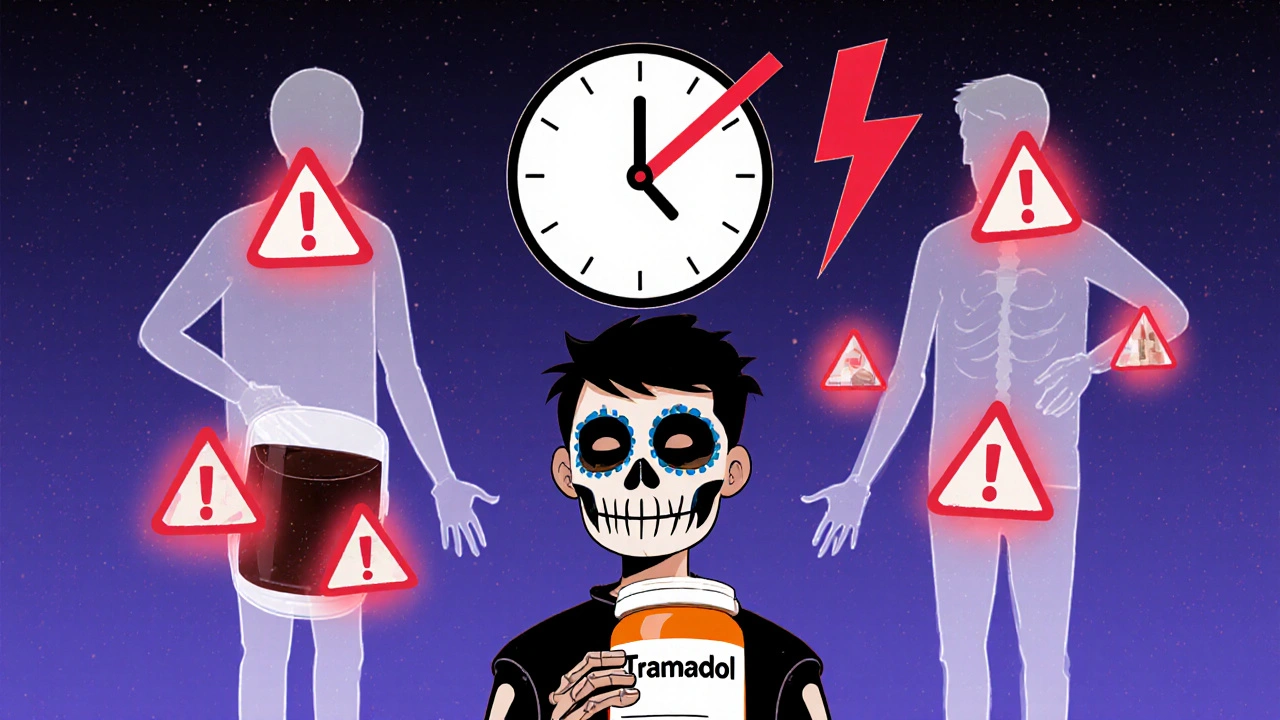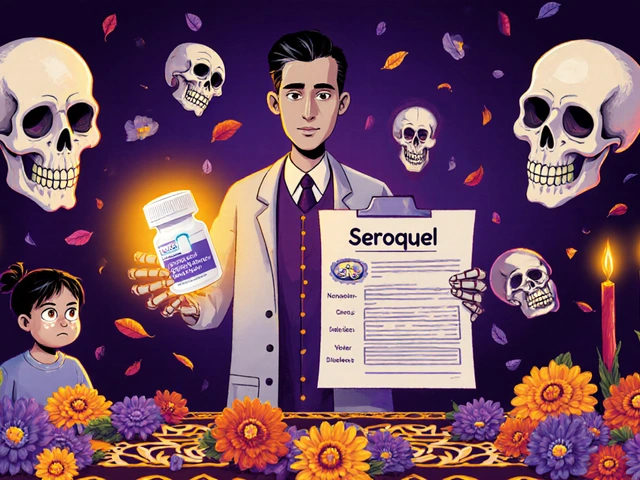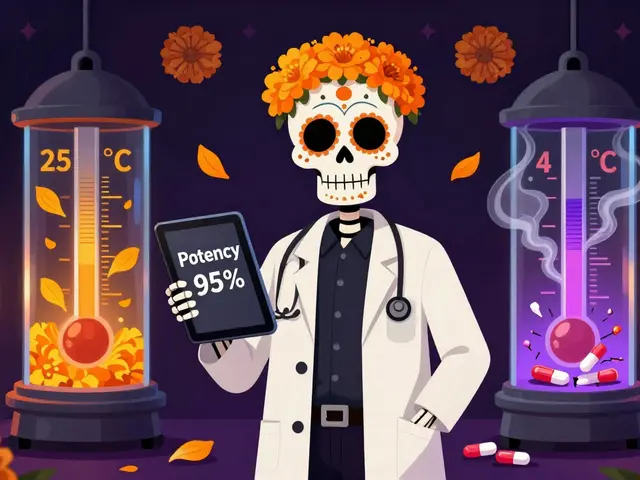Tramadol Seizure Risk Calculator
This tool helps you understand your personal risk of experiencing seizures when taking tramadol, based on your medical history, current medications, and other factors. Tramadol can cause seizures even at normal doses, especially for people with seizure disorders or certain risk factors.
If you have a seizure disorder, taking tramadol could be dangerous-even at normal doses. This isn’t just a theoretical warning. Real patients, taking tramadol exactly as prescribed, have had seizures within hours of their first dose. It doesn’t require an overdose. It doesn’t even require mixing with other drugs. Sometimes, it just takes one pill.
Why Tramadol Can Trigger Seizures
Tramadol isn’t like other painkillers. It works in two ways: as a weak opioid and as a serotonin-norepinephrine reuptake inhibitor. That second part is the problem. By increasing serotonin and norepinephrine in the brain, tramadol disrupts the delicate balance that keeps seizures in check. It reduces the activity of GABA, the brain’s main calming neurotransmitter. Less GABA means neurons fire more easily-and that’s how seizures start. Studies show tramadol lowers the seizure threshold more than other opioids. Morphine, for example, can actually help prevent seizures at low doses. Tramadol? Even at 75 mg a day-the lowest therapeutic dose-it’s been linked to seizures. One patient in a 2016 case report had no history of epilepsy, no drug interactions, and no overdose. Just 75 mg daily. Then, a seizure.Who’s Most at Risk?
Men between 18 and 35 make up the majority of reported cases, but women are not immune. About 7% of tramadol-related seizures occurred in females. Age isn’t the only factor. People with kidney problems are at higher risk because tramadol builds up in the body. One patient with renal failure had a seizure after just 300 mg IV-well below the maximum daily limit of 400 mg. The biggest red flag? A history of seizures. If you’ve ever had one-even years ago-tramadol is not safe for you. The UCSF Pain Management program is clear: tramadol should never be used in patients with seizure disorders. It’s not a suggestion. It’s a hard contraindication.It’s Not Just About Dose
You might think, “I’m only taking 100 mg a day. That’s fine.” But seizures from tramadol happen at all dose levels. A 2013 study of 28 patients found that 46% were taking more than 400 mg daily-but 54% were not. Some took just 50 mg. Others took 300 mg. The seizure didn’t care about the number on the bottle. It cared about the brain’s sensitivity. Even more alarming: seizures often happen within the first 24 hours after taking tramadol. In 89% of cases, they started within a day. That means you could take your first dose on a Monday morning and have a seizure by Tuesday. No warning. No buildup. Just sudden, uncontrolled brain activity.
Drug Interactions Make It Worse
Tramadol becomes far riskier when mixed with other drugs. The most dangerous combinations include:- Tricyclic antidepressants (TCAs) like amitriptyline
- SSRIs like fluoxetine or sertraline
- Antipsychotics like olanzapine or risperidone
- Alcohol
- Other opioids or sedatives
What Do Tests Show?
EEGs taken within 24 hours of a tramadol-induced seizure show abnormalities in nearly half of cases. But here’s the twist: after one week, only 3.6% still had abnormal brain activity. That means the seizure wasn’t caused by permanent damage. It was caused by a temporary chemical imbalance. Once tramadol leaves the system, the brain usually resets. Brain scans rarely show structural changes. In one study of 28 patients, only one person had patchy white matter lesions. That’s not common. This isn’t a brain injury. It’s a pharmacological trigger.What Should You Do Instead?
If you have a seizure disorder and need pain relief, tramadol is off the table. But you still have options. Here are safer alternatives:- Acetaminophen (Tylenol) - Safe for most people with seizure disorders, even at high doses.
- NSAIDs like ibuprofen or naproxen - Effective for inflammation-related pain. Avoid if you have kidney issues.
- Physical therapy and nerve blocks - Non-drug options that reduce reliance on pills.
- Non-opioid prescription options like gabapentin or pregabalin - Sometimes used for nerve pain and don’t lower seizure threshold.

The Bigger Picture
Tramadol became one of the most prescribed opioids in the U.S. between 2008 and 2013. Prescriptions rose 88%. Emergency visits for tramadol-related problems? Up 250%. That’s not a coincidence. The drug was marketed as safer than morphine or oxycodone. But it wasn’t. It just had a different kind of danger. In 2014, the FDA reclassified tramadol as a Schedule IV controlled substance-not because it was addictive like heroin, but because it caused seizures, overdoses, and dangerous interactions. That decision was based on real data, real patients, and real harm.What to Do If You’ve Already Taken Tramadol
If you have a seizure disorder and took tramadol-even once-watch for these signs in the next 24 hours:- Sudden muscle jerks or twitching
- Confusion or staring spells
- Loss of awareness
- Uncontrolled shaking
Final Word
Tramadol is not a harmless painkiller for people with seizure disorders. It’s a known trigger. The science is clear. The warnings are everywhere. The cases are documented. This isn’t speculation. It’s clinical fact. If your doctor prescribes tramadol and you have a history of seizures, say no. Ask for alternatives. Push back. Your brain is worth more than a quick fix for pain.Can tramadol cause seizures even at normal doses?
Yes. Tramadol has caused seizures in patients taking the standard therapeutic dose of 50-100 mg per day. You don’t need to overdose. Even one dose can trigger a seizure in susceptible individuals, especially those with a history of seizures or certain drug interactions.
Is tramadol safe if I had one seizure years ago?
No. If you’ve ever had a seizure-even once, even decades ago-tramadol is contraindicated. The risk isn’t about current seizure control. It’s about your brain’s history. Once a seizure threshold is lowered, it stays vulnerable. Tramadol can reactivate that risk at any time.
How long after taking tramadol can a seizure occur?
Most tramadol-induced seizures happen within the first 24 hours after ingestion. In fact, 89% of cases in clinical studies occurred within that window. The risk is highest right after the first dose or after a dose increase.
Can I take tramadol if I’m on antidepressants?
No. Combining tramadol with SSRIs, SNRIs, or tricyclic antidepressants dramatically increases seizure risk. These drugs also affect serotonin levels, and together they can overwhelm the brain’s ability to regulate electrical activity. This combination has been directly linked to multiple seizure cases in medical reports.
Are there any opioids that are safer for people with seizures?
Morphine and oxycodone have a lower seizure risk than tramadol, but they’re not risk-free. For people with seizure disorders, non-opioid options like acetaminophen, NSAIDs, or nerve pain medications (gabapentin, pregabalin) are preferred. Always consult your doctor before starting any opioid.
Should I stop tramadol if I’m already taking it and have seizures?
Yes. If you’re on tramadol and have a seizure disorder-or if you’ve had a seizure since starting it-stop immediately and contact your doctor. Do not stop abruptly if you’ve been taking it long-term; sudden withdrawal can also trigger seizures. Your doctor can help you taper safely and switch to a safer pain management plan.
Why was tramadol reclassified as a Schedule IV drug?
In 2014, the FDA reclassified tramadol as Schedule IV because of growing evidence of abuse, dependence, and serious side effects-including seizures, overdoses, and dangerous drug interactions. It was no longer considered a low-risk opioid. The seizure risk, in particular, played a major role in this decision.








10 Comments
Scarlett Walker November 14, 2025
Just had to share this-my cousin took tramadol for a back injury and had a seizure within 12 hours. No history, no other meds, just one pill. Doctors acted like it was a fluke until they saw the research. This post saved my life. Thank you.
Never take it lightly. Even if you think you're fine, your brain remembers.
Stay safe, everyone.
Hrudananda Rath November 14, 2025
One is compelled to observe that the author has, with commendable diligence, marshaled an impressive corpus of clinical literature to elucidate the pernicious neuropharmacological implications of tramadol in epileptogenic populations. One might, however, inquire as to the absence of reference to the 2018 meta-analysis by Al-Masri et al., which, though undercited, offers a more granular stratification of seizure risk by CYP2D6 polymorphism. A lamentable oversight, truly.
Brian Bell November 15, 2025
bro this is wild 😳 i took tramadol last year for a toothache and thought i was just ‘feeling weird’-turns out i had a tiny seizure and didn’t even know it. just stared at the wall for 30 seconds. my mom thought i was zoning out. now i’m terrified to take anything.
thanks for the heads up, this post is 🔥
Nathan Hsu November 16, 2025
It is, indeed, a matter of grave concern-yes, a matter of grave concern-that tramadol, marketed as a ‘safer’ opioid, carries such insidious, underappreciated neurotoxic potential; and yet, how many patients, how many families, have been blindsided by this? It is not merely a drug-it is a silent saboteur of neural equilibrium. And yet, we continue to prescribe it, casually, carelessly, as if the brain were a machine that could be tinkered with without consequence.
Ashley Durance November 16, 2025
Let’s be real-this post is accurate, but it’s also alarmist. Most people who take tramadol don’t seize. The real issue is that doctors don’t screen for seizure history properly. If you’re a 25-year-old guy with no history and you take 100mg once? You’re fine. But if you’re on SSRIs, have kidney issues, or lied on your intake form? That’s on you. Stop blaming the drug. Blame the system.
Scott Saleska November 17, 2025
Just wondering-if someone had a single febrile seizure as a toddler, like at age 2, and hasn’t had one since, is that still a contraindication? I’ve seen conflicting info. My doc said it’s fine, but I’m nervous. Anyone else in this boat? I don’t want to miss out on pain relief, but I also don’t want to collapse in the grocery store.
Ryan Anderson November 17, 2025
This is one of the most important posts I’ve read all year. 🙏
My sister had a seizure after tramadol-she was 34, healthy, no meds, no history. The ER docs didn’t even connect the dots until she mentioned the painkiller. Now she’s on gabapentin for nerve pain and does yoga. She’s alive because she spoke up.
Share this. Save someone.
Eleanora Keene November 17, 2025
Hey everyone-just wanted to say thank you for sharing this. I’ve been living with seizures since I was 19, and I’ve had doctors try to push tramadol on me because ‘it’s not that bad.’ No. It’s not ‘not that bad.’ It’s dangerous. I’m so glad someone finally laid this out clearly.
Also-acetaminophen works better than you think for chronic pain. And physical therapy? Life-changing. Don’t give up on non-drug options. You’ve got this 💪
Joe Goodrow November 18, 2025
Why are we letting foreign drug companies get away with this? Tramadol’s a cheap knockoff opioid designed to bypass regulations. The FDA knew. The DEA knew. But they let it flood the market because it made money. Now people are seizing in their kitchens because some pharma exec wanted a bigger bonus. Wake up, America. This is corporate murder.
Don Ablett November 20, 2025
It is noteworthy that the seizure threshold reduction induced by tramadol is dose-independent and primarily mediated by serotonergic and noradrenergic modulation with secondary GABAergic suppression. The temporal clustering of events within 24 hours suggests a pharmacokinetic peak coinciding with neuroexcitatory overload. The absence of structural MRI changes in 96 percent of cases supports a transient neurochemical etiology rather than neurodegenerative injury. Further longitudinal EEG studies are warranted to assess recovery kinetics